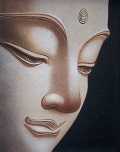Tagged: Asmimana
- This topic has 5 replies, 3 voices, and was last updated 7 months ago by
Yash RS.
-
AuthorPosts
-
-
March 27, 2025 at 10:04 am #53941
Amin
ParticipantHello everybody,
This is a Dhamma sermon delivered by Venerable Deegoda Dhammadassi to a group of Dhamma practitioners. It focuses a lot on Asmimana and also touches on things like Anicca, Dukkha, Anatta, and Paticcasamuppada.
Some of the questions that were sent:
1. Is it possible for anyone below an Arahant to experience an uncontaminated Citta (Pañcakkhandha)?
For example, let’s consider an ordinary person experiencing a visual event:
When light reflects off an object and reaches the physical eye, it triggers a chain reaction. This reaction generates electrical impulses, which travel through the optic nerve to the visual cortex of the brain. The brain processes these signals into a form the mind can comprehend, then transmits them via Cakkhu Pasāda. This results in the arising of a Citta, which includes fractions of Rūpa, Vedanā, Saññā, Saṅkhāra, and Viññāṇa. At this moment, a fraction of visual experience occurs.However, for anyone below an Arahant, due to Avijjā (ignorance) regarding the true nature of reality (Anicca, Dukkha, Anatta), a false sense of self (“I”) is added to this experience.
This creates the illusion of an “I” that is experiencing the sight.
Is this correct? If so, does that mean all our experiences are always contaminated by ignorance? In other words, do we always experience Pañcūpādānakkhandha rather than Pañcakkhandha?
In this context, how does a Sotāpanna perceive the sense of “I”?
Here’s the video: The Tower of Nibbāna
And here’s the transcription: The Tower of NibbānaFeel free to check it out and share any thoughts!
1 user thanked author for this post.
-
March 27, 2025 at 6:57 pm #53942
Lal
KeymasterI have been traveling the whole day and just saw Amin’s post. I have not watched the video.
- A puthujjana has never experienced pañcakkhandha (which is free of defilements). It is also called pabhassara citta.
- It is pañcaupadanakkhandha that arises for a puthujjana with any sensory input. Then they always attach to it in the “purana kamma” stage with at least avijja.
I would like to see this discussed. It is a critically important issue.
-
March 27, 2025 at 7:49 pm #53943
Amin
ParticipantSorry for the unintended restriction on the PDF file. I’ve removed it now, so everyone should be able to download and view it.
1 user thanked author for this post.
-
March 28, 2025 at 6:23 am #53944
Yash RS
ParticipantI have read the transcription till page 13. It exactly addresses what we need to focus on.
Also the Anicca, Dukkha, Anatta meaning is the same as interpreted by Jethvanarama Buddhist monastery. It says things are based on causes and conditions, that’s why we cannot keep them the way we want. This is how expectation arises as we “fix” that effect as an entity and perceive essence in it.
The thero has perfectly explained all that and how all the three are interconnected.
Thanks Amin for this valuable piece of Dhamma.
1 user thanked author for this post.
-
March 28, 2025 at 1:21 pm #53947
-
-
March 28, 2025 at 7:27 am #53945
Lal
KeymasterAmin asked:
“However, for anyone below an Arahant, due to Avijjā (ignorance) regarding the true nature of reality (Anicca, Dukkha, Anatta), a false sense of self (“I”) is added to this experience.
This creates the illusion of an “I” that is experiencing the sight.
Is this correct? If so, does that mean all our experiences are always contaminated by ignorance? In other words, do we always experience Pañcūpādānakkhandha rather than Pañcakkhandha?
In this context, how does a Sotāpanna perceive the sense of “I”?“
______
The “distorted saññā” makes one think certain sensory inputs are “valuable/enjoyable,” i.e., they are of icca, sukha, and atta nature.
- That leads to the following three results: (i) one attaches to it with tanhā thinking, “this is suitable to be mine” (etaṁ mama), (ii) One generates a sense of “me/mine” or asmi māna (esohamasmi), and (iii) One generates the wrong view or “diṭṭhi” that such things are beneficial.
- A Sotapanna only removes the third one, specifically sakkāya diṭṭhi.
- The next one to be removed is tanhā, which is removed in three stages. Kāma tanhā is lessened at the Sakadāgāmi stage and removed at the Anāgāmi stage. Rupa tanha and arupa tanha are removed at the Arahant stage.
- The last one to be removed is asmi māna, which is the sense of a “me/mine.” That is removed only at the Arahant stage.
See “Etaṁ Mama, Esohamasmi, Eso Me Attā’ti – What Does It Mean?” and “Fooled by Distorted Saññā (Sañjānāti) – Origin of Attachment (Taṇhā).”
1 user thanked author for this post.
-
-
AuthorPosts
- You must be logged in to reply to this topic.
